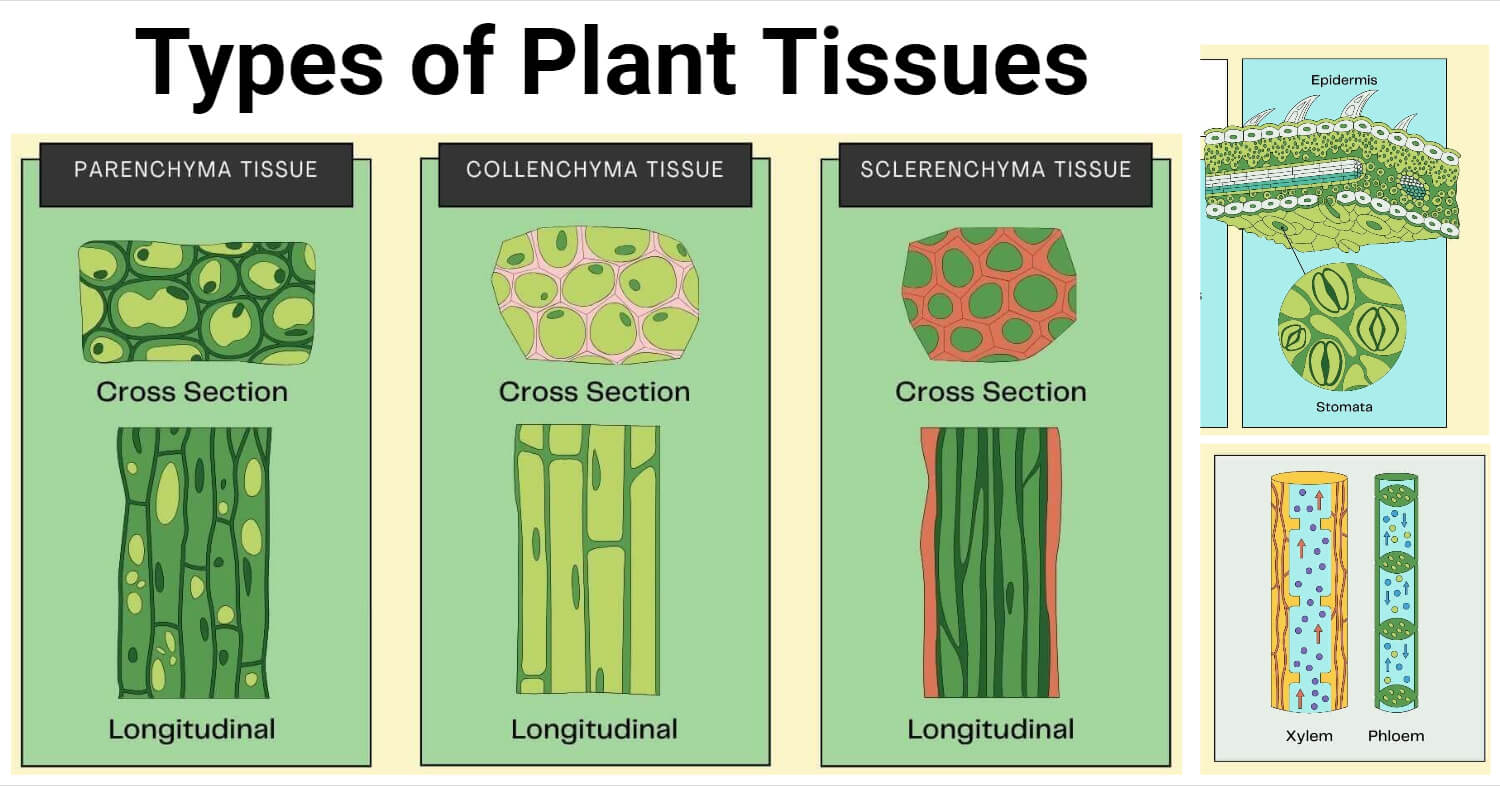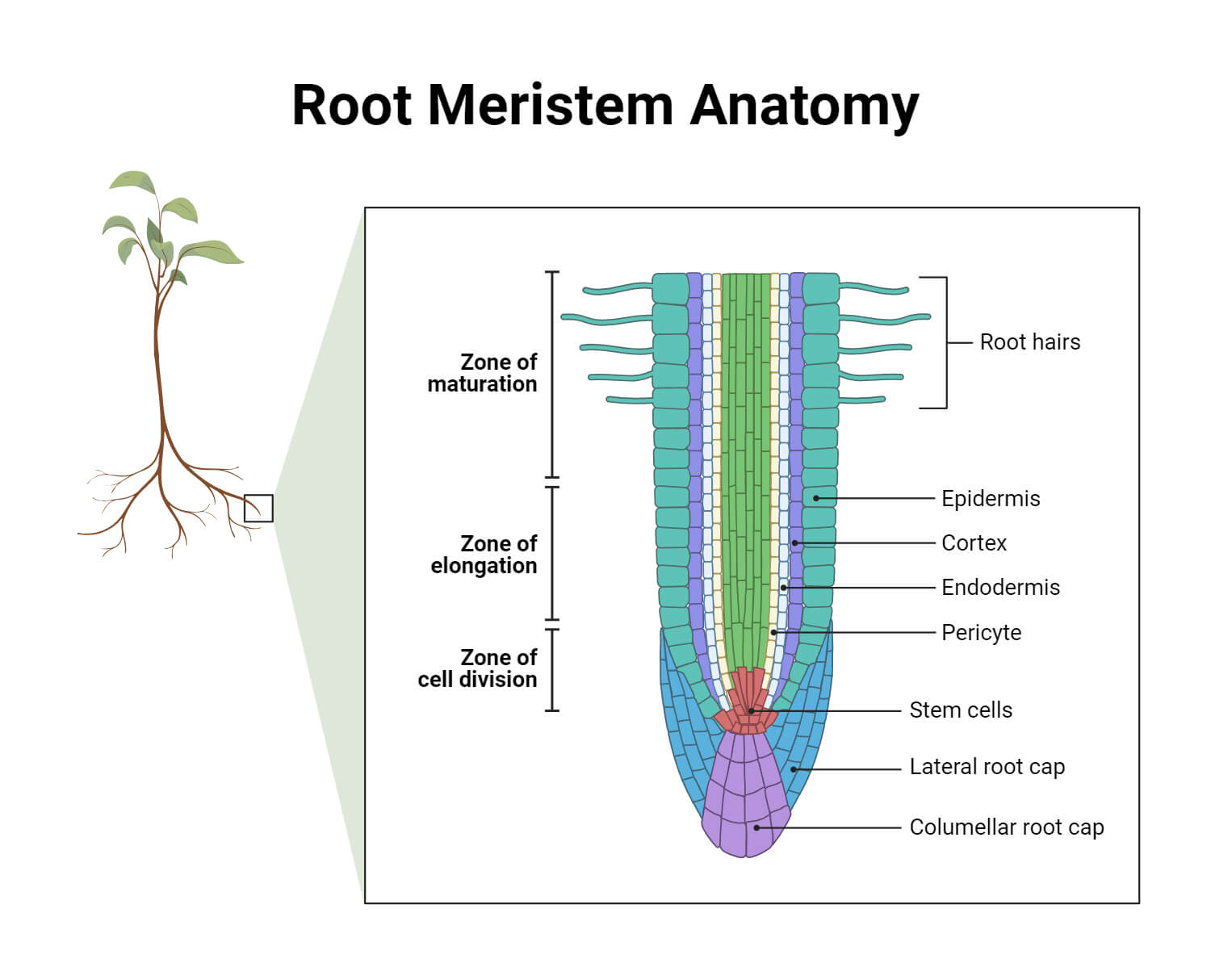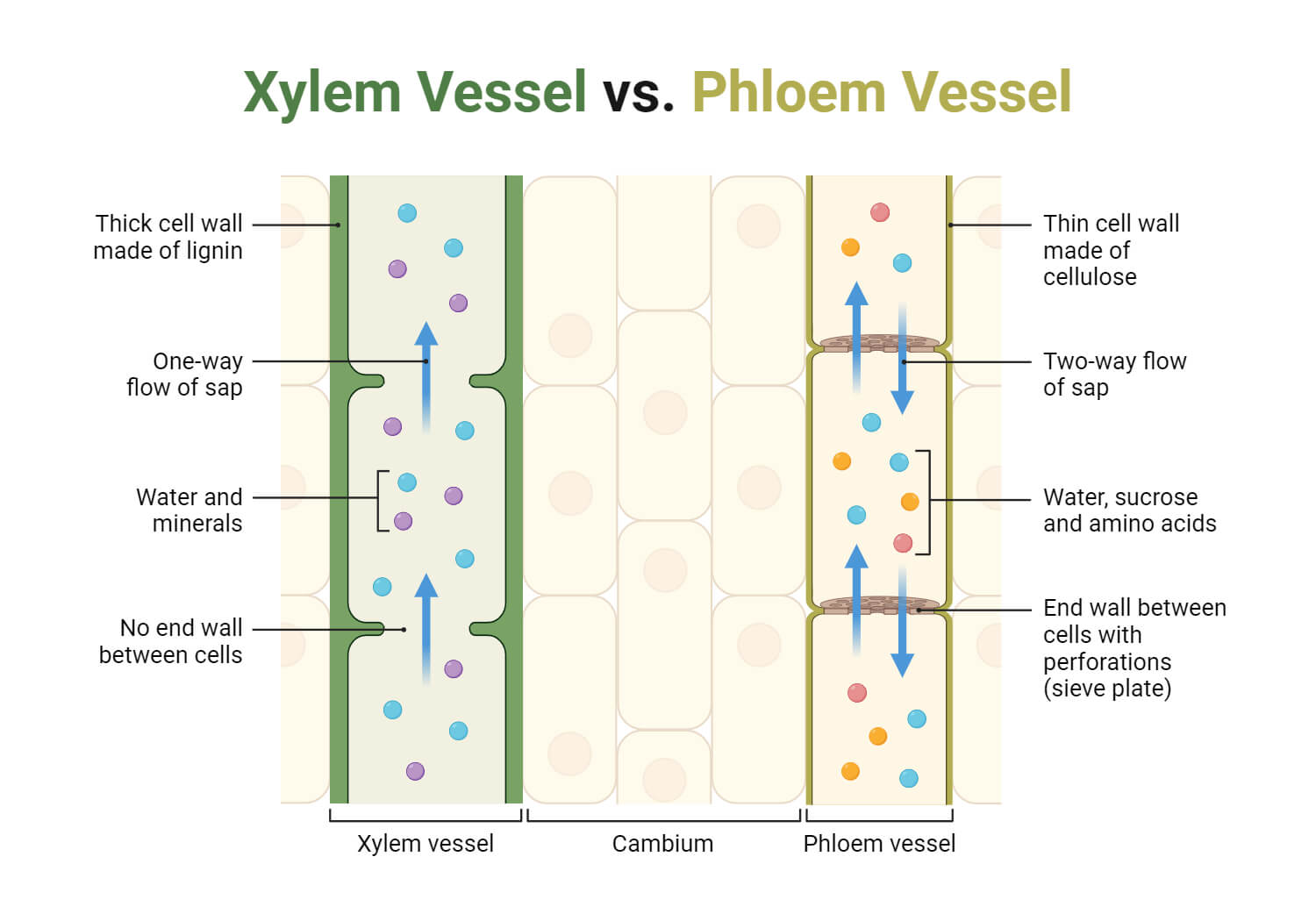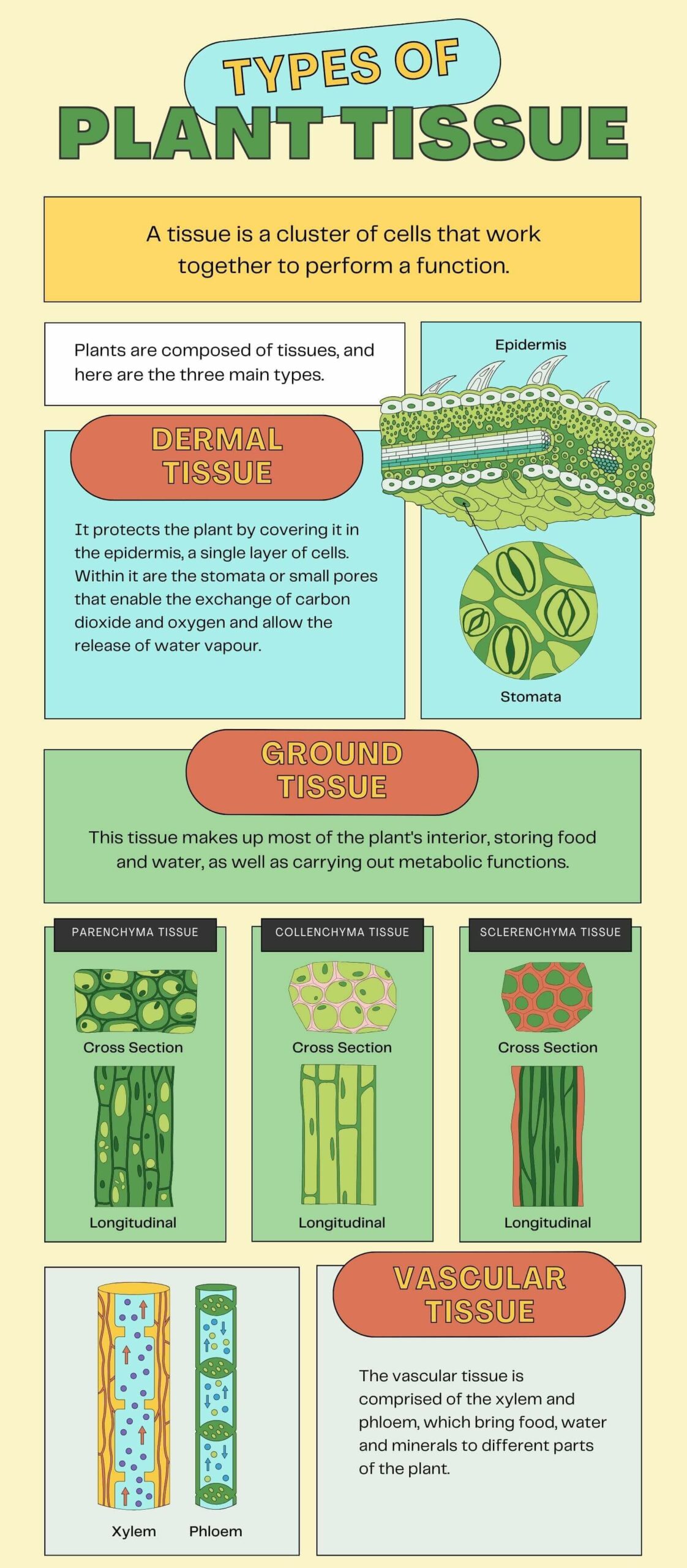Plant Anatomy is the branch of botany that studies internal structures of plant organs like roots, stems, leaves, etc, by slicing them into thin sections and examining them under a microscope. The father of plant anatomy is Nehemiah Grew.

A group of similar or dissimilar cells having a common origin and performing a common function is called tissue. The term ‘tissue’ was also coined by Nehemiah Grew.
Interesting Science Videos
Types of Plant Tissues
- Meristematic Tissue
- Permanent Tissue
1. Meristematic Tissue
Meristematic tissues consist of cells that undergo continuous division, known as “meristem.” The term “meristem” originates from the Greek word “meristos,” meaning divisible, and was coined by Carl Nageli.
Characteristics of a meristematic tissue
- Meristematic tissues are composed of small, living, thin-walled, undifferentiated cells.
- Their cell wall is thin and cellulose in nature and consists of the primary wall only. The secondary wall is absent.
- These cells have a large nucleus located centrally.
- Vacuoles are generally absent in meristematic tissues but, if present, they are small and scattered throughout the cytoplasm.
- Meristematic cells possess the capacity of cell division.
- Meristematic cells are usually isodiametric in shape. However, other shapes like spherical, oval, and polygonal also occur.
- Cells are compactly arranged without leaving any intercellular space between the cells.
- Ergostic substances are absent in the cell.
- Plastids occur in the proplastid stage.
Classification of Meristematic Tissues
A. Classification of Meristematic Tissues Based on origin and development
a. Promeristem
The earliest and youngest group of meristems occurs from the embryonic stage of plant life. Hence, this meristem is also called embryonic meristem. It occurs as a small mass at the tip of the plant organs like the root, stem, leaves, or the primordia of leaves or similar appendages. Hence, this meristem is also called ‘primordial meristem’. They are the site of the initiation of new organs in the plant body. Example: meristem present in the embryo, meristem present at the tip of plant organs, etc.
b. Primary meristem
Primary meristems are formed from the promeristem as the promeristem cells changes in shape and size. These meristems are initially present in the plant body during its early stages and retain their meristematic nature. They are responsible for generating primary permanent tissue and establishing the fundamental structure of plants.Examples: Intrafassicular cambium, apical meristem of root, stem, leaves, intercalary meristem, etc.
c. Secondary meristem
Those meristems that develop from the permanent tissues when these tissues regain their power of cell division are secondary meristems. Secondary meristems are formed by de-differentiation, of the permanent tissues. The secondary meristems were not present from the early stages of plant life but were later formed from the permanent tissues by de-differentiation. They are formed at the time of secondary growth or healing of wounds. The secondary meristem gives rise to secondary tissues and helps in secondary growth. Examples: interfascicular cambium, cambium of root, cork cambium of stem and root, callus tissue that develops during plant tissue culture, etc.
Differentiation- The process of conversion of an undifferentiated meristem tissue into a permanent tissue is called differentiation.
De-differentiation- It is the process of conversion of a fully differentiated permanent tissue into a meristematic tissue.
B. Classification of Meristematic Tissues Based on their position in the plant body
a. Apical meristem
Those meristems that occur at the tip of the plant body like roots, stems, leaves, etc are apical meristems. It consists of promeristem and primary meristem. It helps in increasing the length of the plant body. The apical meristem in the case of phanerogams consists of a group of meristematic cells called apical initial or apical cells. However, in the case of pteridophytes, the apical meristem consists of a single cell called the apical cell.
b. Intercalary meristem
They are those meristems occurring between permanent tissues and are formed when the actively dividing meristems, meristematic tissue present at the tip get detached due to growth in length of the plant body. They occur at the base of the leaf as in Pinus at the base of the node as in Mint, or at the base of the internode as in grasses and horsetail.
c. Lateral meristem
They are those meristems that occur laterally and are parallel to the circumference of the plant organ. Most of the lateral meristem are secondary meristems. They help in increasing the thickness or the girth of the plant body. Example: intrafascicular and interfascicular cambium, cambium of roots, cork cambium of stem and root, etc.

C. Classification of Meristematic Tissues Based on their function
a. Protoderm
It is the outermost layer of meristem that gives rise to the epidermal tissue system.
b. Procambium
It lies inner to the protoderm and it gives rise to the va scular tissue system. The procambium strands are scattered in the case of a monocot stem. The procambium strands are arranged in a ring in case of a dicot stem. However, in the case of a root, there is only a single cambium strand at the center.
c. Ground meristem
It is the rest of the meristem excluding the protoderm and procambium. It gives rise to the ground tissue system which consists of hypodermis, cortex, endodermis, pericycle, medullary rays, and pith.
D. Classification of Meristematic Tissues Based on their plane of division
a. Mass meristem
In this type of meristem, division occurs in three planes or all possible plane leading to an increase in the thickness, mass, or volume of the plant body. Example: meristem that forms the sporangia, endosperm, etc.
b. Plane meristem
In this type of meristem, division occurs anticlinally in two planes. It leads to the formation of a plate-like increase in area. Example: meristem that forms the leaf-lamina, epidermis, etc.
c. Rib meristem
In this type of meristem, division occurs anticlinally in one plane only leading to the formation of a row of cells. Example: meristem that forms the filament of algae or young cortex.
2. Permanent Tissue
Permanent tissues are those tissues that have lost their power of cell division and have attained a definite shape and performing a definite function. They are formed from the meristematic tissues by differentiation.
Types of permanent tissues
1. Simple Permanent Tissue
It is a type of permanent tissue composed of only one type of cells. Hence, they are also known as homogenous tissue. It is of three types:
A. Parenchyma
Parenchyma consists of thin-walled, living, differentiated cells. The parenchymatous cells are usually isodiametric in shape. However, others are oval, polygonal, or rounded. The cell wall of parenchyma cells is thin and made up of cellulose, hemicellulose, and pectin. They usually possess intercellular spaces between the cells. They form the major bulk of the plant body. Parenchyma cells are of the following types:
1. Simple parenchyma
They are abundantly found parenchyma cells. They are composed of thin-walled, more or less isodiametric cells with intercellular spaces between the cells. They are found in the pulp of fruits, cortex, medullary rays, and pith of plant organs.
2. Chlorenchyma
It is also a special type of parenchyma that is rich in chloroplasts. These cells aid in photosynthesis as they contain chloroplasts. They are found in green parts of the plant body like leaves, young green stems, sepals of flowers, young fruits, etc. The mesophyll tissue of leaves is also chlorenchyma tissue composed of two types of parenchyma viz. palisade parenchyma and spongy parenchyma.
3. Idioblast
It is the type of parenchyma that stores oils, tannin crystals of calcium oxalate, etc.
4. Prosenchyma
It is a type of parenchyma with very thick walls. They are elongated cells with tapered ends. They are found in the pericycle of some plants. They provide mechanical support.
5. Epiblema
It is the outermost layer of roots. It is composed of thin-walled parenchyma cells without any intercellular spaces between the cells. They lack cuticles and some cells produce unicellular root herbs. So, epiblema is also called the piliferous layer.
6. Epidermis
It is the outermost layer of the aerial portion of the plant body. It is composed of thin-walled, compactly arranged parenchymatous cells without any intercellular spaces between the cells. The epidermis possesses a thick or thin layer of cuticle. Multicellular epidermal hairs may also be present.
7. Xylem parenchyma
These are parenchyma cells associated with the xylem tissue. They are composed of thin-walled elongated parenchyma cells that help in the storage of food and slow lateral conduction of water and minerals.
8. Phloem parenchyma
These are parenchyma cells associated with phloem tissue. They are composed of thin-walled elongated parenchyma cells that help in the storage of food and slow lateral conduction of prepared food.
B. Collenchyma
Collenchyma occurs in the stem of herbaceous dicotyledons in the form of two layers below the epidermis and forms a layer called the hypodermis. It is present in roots and monocotyledons except in some special cases. The presence of hemicellulose and pectin substances in the thickened walls endow tissue with the capacity to expand and give tensile strength to the organs. It is of three types:
- Angular collenchyma:
It is thickened on all sides due to the deposition of cellulose and pectin.
- Lamella:
It is the type of collenchyma where the tangential walls are only thickened due to the deposition of cellulose and pectin.
- Lacunate collenchyma:
It is the type of collenchyma where lacum is present and the walls without lacuma are thickened due to deposition of cellulose and pectin.
C. Sclerenchyma
Sclerenchyma consists of long, narrow, thick-walled, and lignified cells. They are dead cells and don’t perform any metabolic activities. They are usually pointed at both ends and are fiber-like in appearance, hence they’re also known as sclerenchyma fibers. They have simple, often oblique pits in their walls. They are found abundantly in plants and occur in patches or in definite layers.
There are two types of sclerenchyma:
Fibers
They are long, have tapered ends, and are thick-walled. The fully developed fibers are always dead. They have a narrow lumen and a thick secondary wall.
Sclereids
They are externally thick-walled and may be spherical, oval, cylindrical, T-shaped, dumbbell-shaped, or stellate. The walls show simple pits and they are generally found in hard parts of the plant body, rarely in fruit pulps.
2. Complex Permanent Tissue
Complex permanent tissue is found in all vascular plants and they perform a common function. There are two types of complex permanent tissues:
Xylem
Xylem is a complex tissue that is mainly responsible for the conduction of water and saps inside the plant from the root to the top of the plant. It also provides mechanical strength. It is composed of four kinds of cells: tracheids, vessels, xylem parenchyma, and xylem fibers.
Tracheids are elongated, tube-like dead cells with tapering ends that have hard, lignified cell walls and a large cell cavity or wide lumen. Vessles are rows of elongated dead cells placed end to end. Their transverse walls are dissolved; which is called simple perforation plate. They look like a series of pipes. Parenchyma cells associated with xylem is xylem parenchyma. Sclerenchyma cells associated with xylem is xylem fiber.

Phloem
Phloem is a complex tissue that is responsible for the conduction and distribution of organic nutrients, or plant food. It is composed of three types of cells: sieve tubes, companion cells, phloem fibers, and phloem parenchyma.
Sieve tubes are nuclei-less, organelle-less cells that are responsible for transportation of plant food. Companion cells contain a large nucleus and they are elongated cells. They aid in transport of food along with sieve tubes. Phloem fibers provide mechanical strength to phloem specifically. Parenchyma cells associated with phloem is phloem parenchyma.

References
- An Introduction to Plant Structure and Development: Plant Anatomy for the … – Charles B. Beck – Google Books
- Plant anatomy and physiology – ScienceDirect
- Esau’s Plant Anatomy: Meristems, Cells, and Tissues of the Plant Body: Their … – Ray F. Evert – Google Books
- Kerstetter RA, Hake S. Shoot Meristem Formation in Vegetative Development. Plant Cell. 1997;9(7):1001-1010. doi:10.1105/tpc.9.7.1001
- Integrative Plant Anatomy – William C. Dickison – Google BooksPhloem: Cell Types, Structure, and Commercial Uses | IntechOpen
- Meristematic Tissues – Definition, Features, Types, Role – GeeksforGeeks
- Plant tissues – BIOLOGY4ISC (weebly.com)
- Meristematic tissue | PPT (slideshare.net)
- Permanent Tissue | adda247
